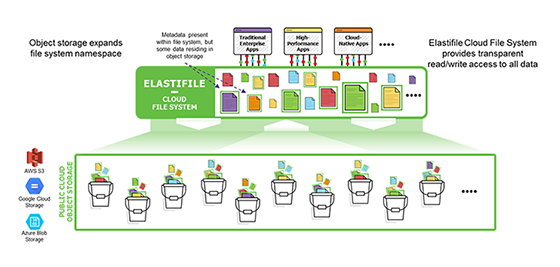Elastifile adds automated tiering to cloud object storage
Cloud file system startup Elastifile is making it easier to shift data to object storage in Amazon and Google using ClearTier policy-based automated tiering.
Cloud file system startup Elastifile Ltd. added new capabilities to automatically tier file data to low-cost cloud object storage.
The new ClearTier functionality in Elastifile 3.0 enables customers to set policies to shift data from file storage to less expensive object storage without having to change the application code. Elastifile supports Automated tiering to bare-metal servers located on premises and to Amazon Web Services (AWS) and Google Cloud Platform, with plans to support Microsoft Azure in the future.
Jerome McFarland, Elastifile vice president of marketing, said the vendor has SAP users who want to migrate their data to cloud storage and don't necessarily need blazing-fast performance. He said the new ClearTier tool could also help enterprises shift data center workloads to the cloud for temporary access to the GPU or CPU resources they lack on premises.
"The point of all this is to enable enterprises to keep their cloud infrastructure costs in alignment with the performance requirements of the application," McFarland said. "We want to make sure they have the flexibility to meet the need of the application and not have to overpay."
On-demand cloud bursting
Elastifile customer eSilicon Corp. bursts its semiconductor design workflows to Google Cloud when it needs additional compute and storage capacity on demand, McFarland said. He said eSilicon pays for the cloud resources only during peak times and tears down the cloud infrastructure when the work is done.
Marc Staimer, president of Dragon Slayer Consulting, said Elastifile's pricing model is a key differentiator. Other vendors with distributed cloud file systems, such as WekaIO and Microsoft Avere, don't offer on-demand licensing.
"If you look at the way file systems are charged in the cloud, it's very expensive. It's not very expensive with Elastifile," Staimer said. "They're designed for the hybrid cloud more than anybody I've seen as far as the way they license. They really focus on seamlessly utilizing the cloud in the way it was designed to be used -- on demand while you're in a hybrid mode."
Enterprise-grade file storage
Elastifile focuses on enterprise-grade file storage. Its distributed Elastifile Cloud File System (ECFS) was designed to pool flash storage in commodity servers located in private and public clouds and present it to applications using a single global namespace.
This year, Elastifile added support for standard HDDs that are directly attached to cloud-based VMs or supplied as pooled block storage in AWS or Google. The company continues to require flash-based SSDs for on-premises deployments of ECFS on bare-metal servers.
Elastifile CloudConnect capabilities can translate file data from on-premise NAS systems into the object formats of popular cloud storage providers, such as Amazon's Simple Storage Service and Google Cloud Storage. CloudConnect software also encodes the file system's structural information, including hierarchies and attributes, into the objects.
Before Elastifile 3.0, customers could send file data to and from object storage manually. McFarland said applications could see and access data physically stored in the Elastifile file system. But any data in object storage had to be manually checked out into the file system to make it visible to the applications.

New ClearTier capability
McFarland said Elastifile 3.0 and ClearTier allow applications to see and process all the file data, even when it resides on object storage. ClearTier gives the file system access to the metadata of the object-based data and provides a unified namespace between the file and object.
ClearTier operates in the background, serving up data to applications using ECFS in an automated fashion based on the customer's set policies. The applications don't need to know where the data is stored because they only interact with ECFS using standard NFS.
"Traditional enterprise apps -- especially high-performance apps -- still want to talk to a file system," said Scott Sinclair, a senior analyst at Enterprise Strategy Group. "Elastifile's scale-out file system can serve the traditional apps that need to talk to NFS. Then, with ClearTier, they provide access to this lower cost, massively scalable object store that could be on the public cloud or on premises."
Customers can specify their desired capacity ratio between file and object storage and set policies to demote data to object storage based on factors such as frequency of access. McFarland said Elastifile plans to give customers more granular control over automated data tiering in the future.
Another new capability in Elastifile 3.0 is the ability to store snapshots in object storage. Customers can choose which data they want to include in the snapshots and specify the schedule for snapshot creation.
One potential limitation for Elastifile customers is the inability to use cloud-based services, such as analytics, on the object data they store in the public cloud. Users would first need to rehydrate the data using the Elastifile software, McFarland said. However, Elastifile has worked internally to enable external applications to directly consume its objects.
"For us, it's just a mapping from our encoded object format to the standard object format that other applications would use," McFarland said. "Today, we're not exposing that because, in all honesty, we haven't seen that much pull for that yet. But it's something that I think we may expose moving forward."
Elastifile competition
McFarland said Elastifile's competition includes in-house offerings from cloud service providers, including AWS Elastic File System (EFS) and Microsoft Azure Files, and products from traditional on-premises, hardware-centric vendors that are trying to integrate cloud capabilities, such as NetApp Cloud Volumes.
One key advantage for Elastifile is the price. Amazon charges 30 cents per GB, per month for EFS, but Elastifile with ClearTier could potentially lower costs to three cents per GB, per month after data compression, McFarland said.
Henry Baltazar, a research vice president at 451 Research, said Elastifile's multi-cloud capability is another key differentiator. He pointed out that hyperscalers such as AWS and Google "have little interest in moving data out of their cloud to a rival service provider." Baltazar believes that Elastifile's decision to focus on high-performance use cases is a good strategy because "they will face less competition there and can differentiate on performance."
George Crump, founder and president of Storage Switzerland, said few cloud file system vendors offer the ability to tier data intelligently between different classes of cloud storage. In addition to cloud service providers, Crump sees SoftNAS as another key competitor for Elastifile.







